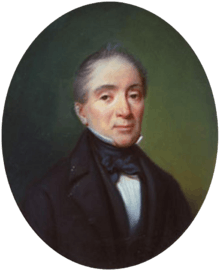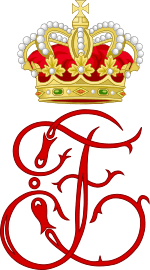Florestan, Prince of Monaco
Florestan (Tancrède Florestan Roger Louis Grimaldi; 10 October 1785, in Paris – 20 June 1856) was Prince of Monaco and Duke of Valentinois from 2 October 1841 until his death. He was the second son of Prince Honoré IV and Louise d'Aumont Mazarin and succeeded to the throne on the death of his brother, Honoré V.
| Florestan | |||||
|---|---|---|---|---|---|
 | |||||
| Prince of Monaco | |||||
| Reign | 2 October 1841 – 20 June 1856 | ||||
| Predecessor | Honoré V | ||||
| Successor | Charles III | ||||
| Born | 10 October 1785 Paris, France | ||||
| Died | 20 June 1856 (aged 70) Paris, French Empire | ||||
| Burial | Saint Nicholas Cathedral | ||||
| Spouse | |||||
| Issue | |||||
| |||||
| House | Grimaldi | ||||
| Father | Honoré IV, Prince of Monaco | ||||
| Mother | Louise d'Aumont | ||||
Early life, education, and military career
Brought up by his mother, he showed an early and strong aptitude for literature.[1] At the age of eleven, he enrolled in the School of Fontainebleau, but did not stay there long.[1] He entered the military, where he had many struggles and barely achieved the rank of Corporal.[2] He was taken prisoner during the French invasion of Russia.[1] He was not freed to return to France until 1814.[1]
Marriage and children
Prince Florestan, age 29, married Maria Caroline Gibert de Lametz in Commercy on 27 November 1816. Apparently, his family disapproved of the union, so they had to marry "quietly and modestly."[3] Florestan received only a small income from his family, so, as it turned out, his marriage to an upper-bourgeois family member of the province of Champagne[1] was, in fact, "financially favorable."[3]
The marriage produced the following:
- Charles III, Prince of Monaco (1818–1889)
- Florestine Gabrielle Antoinette Grimaldi, Princess of Monaco (2/22 October 1833 in Fontenay-aux-Roses – 4/24 April 1897 in Stuttgart), married in Monaco on 15 February 1863 as the second wife of Wilhelm, 1st Duke of Urach. She was the mother of Wilhelm, who was an heir presumptive to the Throne of Monaco and reigned for a few months as King Mindaugas II of Lithuania.
Reign

Florestan was ill-prepared to assume the role of Sovereign Prince.[1] Indeed, the British historian H. Pemberton wrote that, upon accession to the throne, Florestan was "a man utterly unsuited for the task before him."[4] He had been an actor in the Théâtre de l'Ambigu-Comique.[3] The real power during his reign lay in the hands of his wife, Princess Caroline, who possessed great intelligence[1] and "excelled at social skills."[3] According to the historian Gustave Saige, Princess Caroline's intelligence was required to figure out the affairs of state, which Honoré V had handled absolutely by himself, not trusting anyone to advise or assist him.[1] For some time, she was able, by tax reform,[1] to alleviate the difficult economic situation stemming from the Congress of Vienna assigning Monaco as a protectorate of the Kingdom of Sardinia rather than France.[3][5]
As unprepared as Florestan was for the affairs of the Principality, his ascendance to power upon the death of his brother was largely welcomed by the populace. "He was given a particularly warm reception by the people of Menton," wrote Saige in French. Saige attributed the cause for this to the relief widely felt at having a prince who was not invisible to the public; unlike Honoré V, Florestan went out in public. He even established a school in Menton, albeit an expensive one from which the princely couple attempted to meet local demands for democratic reforms and offered two constitutions to the local population, but these were rejected, particularly by the people of Menton, who were offered something better by King Charles Albert of Sardinia.[3] When the Prince and Princess of Monaco saw that their efforts were doomed to failure, they handed over power to their son Charles (later Prince Charles III).[3] This was, however, too little, too late. Encouraged by the French Revolution of 1848, the towns of Menton and Roquebrune revolted and declared themselves independent. Worse, the King of Sardinia garrisoned Menton,[6] Florestan was dethroned, arrested, and imprisoned.[3] Florestan was restored to the throne in 1849, but Menton and Roquebrune were lost forever.
Death and succession, 1856
Despite his good intentions, by the time of Florestan's death in Paris in 1856, Monaco was a country divided with few prospects for financial prosperity. It remained for his heir to remedy the situation.
Ancestry
| Ancestors of Florestan, Prince of Monaco | ||||||||||||||||||||||||||||||||||||||||||||||||||||||||||||||||||||||||||||||||||||||||||||||||||||||||||||||||||||||||||||||||||||||||||||||||||||||||||||||||||||||||||||||||||||||||||||||||||||||||||||||||||||||||||||||||||||||||||||||||||||||||||||||||||||||||||||||||||||||||||||||||||||||||||||||||||||||||||||||||||||||||||||||||||||||||||||||||||||||||||||||||||||||||||||||||||||||||||||||||||||||||||||||||||||||||||||||||||||||||||||||||||||||||||||||||||||||||||||||||||||||||||||||||||||||||||||||||||||||||||||||||||||||||||||||||||||||||||||||||||||||||||||||||||||||||||||||||
|---|---|---|---|---|---|---|---|---|---|---|---|---|---|---|---|---|---|---|---|---|---|---|---|---|---|---|---|---|---|---|---|---|---|---|---|---|---|---|---|---|---|---|---|---|---|---|---|---|---|---|---|---|---|---|---|---|---|---|---|---|---|---|---|---|---|---|---|---|---|---|---|---|---|---|---|---|---|---|---|---|---|---|---|---|---|---|---|---|---|---|---|---|---|---|---|---|---|---|---|---|---|---|---|---|---|---|---|---|---|---|---|---|---|---|---|---|---|---|---|---|---|---|---|---|---|---|---|---|---|---|---|---|---|---|---|---|---|---|---|---|---|---|---|---|---|---|---|---|---|---|---|---|---|---|---|---|---|---|---|---|---|---|---|---|---|---|---|---|---|---|---|---|---|---|---|---|---|---|---|---|---|---|---|---|---|---|---|---|---|---|---|---|---|---|---|---|---|---|---|---|---|---|---|---|---|---|---|---|---|---|---|---|---|---|---|---|---|---|---|---|---|---|---|---|---|---|---|---|---|---|---|---|---|---|---|---|---|---|---|---|---|---|---|---|---|---|---|---|---|---|---|---|---|---|---|---|---|---|---|---|---|---|---|---|---|---|---|---|---|---|---|---|---|---|---|---|---|---|---|---|---|---|---|---|---|---|---|---|---|---|---|---|---|---|---|---|---|---|---|---|---|---|---|---|---|---|---|---|---|---|---|---|---|---|---|---|---|---|---|---|---|---|---|---|---|---|---|---|---|---|---|---|---|---|---|---|---|---|---|---|---|---|---|---|---|---|---|---|---|---|---|---|---|---|---|---|---|---|---|---|---|---|---|---|---|---|---|---|---|---|---|---|---|---|---|---|---|---|---|---|---|---|---|---|---|---|---|---|---|---|---|---|---|---|---|---|---|---|---|---|---|---|---|---|---|---|---|---|---|---|---|---|---|---|---|---|---|---|---|---|---|---|---|---|---|---|---|---|---|---|---|---|---|---|---|---|---|---|---|---|---|---|---|---|---|---|---|---|---|---|---|---|---|---|---|---|---|---|---|---|---|---|---|---|---|---|---|---|---|---|---|---|---|---|---|---|---|---|---|---|---|---|---|---|---|---|---|---|---|---|---|---|---|---|---|---|---|---|---|---|---|---|---|---|---|---|---|---|---|---|---|---|---|---|---|---|---|---|---|---|---|---|---|---|---|---|---|---|---|---|---|---|---|---|---|---|---|---|---|---|---|---|---|---|---|---|---|---|---|---|---|---|---|---|---|---|---|---|---|---|---|---|---|---|---|---|---|---|---|---|---|---|---|---|---|---|---|---|---|---|---|---|---|---|---|---|---|---|---|---|---|---|
| ||||||||||||||||||||||||||||||||||||||||||||||||||||||||||||||||||||||||||||||||||||||||||||||||||||||||||||||||||||||||||||||||||||||||||||||||||||||||||||||||||||||||||||||||||||||||||||||||||||||||||||||||||||||||||||||||||||||||||||||||||||||||||||||||||||||||||||||||||||||||||||||||||||||||||||||||||||||||||||||||||||||||||||||||||||||||||||||||||||||||||||||||||||||||||||||||||||||||||||||||||||||||||||||||||||||||||||||||||||||||||||||||||||||||||||||||||||||||||||||||||||||||||||||||||||||||||||||||||||||||||||||||||||||||||||||||||||||||||||||||||||||||||||||||||||||||||||||||
| Preceded by Honoré V |
Prince of Monaco Duke of Valentinois 1841–1856 |
Succeeded by Charles III |
References
- Saige, Gustave (1897). Monaco: Ses Origines et Son Histoire. Imprimerie de Monaco. Retrieved 2 December 2017.
- De la Canorgue, Victor (1851). Les règnes d'Honoré V et de Florestan I, princes de Monaco (Digital ed.). University of Lausanne. Retrieved 4 December 2017.
- "FLORESTAN I – A PRINCE OF MONACO THROUGH NO CHOICE OF HIS OWN". Hello Monaco. Archived from the original on 4 July 2017. Retrieved 3 December 2017.CS1 maint: BOT: original-url status unknown (link)
- Pemberton, H. (1867). The History of Monaco: Past and Present. London: Tinsley Brothers. Retrieved 19 December 2018.
- Eccardt, Thomas M. (2005). Secrets of the Seven Smallest States of Europe: Andorra, Liechtenstein, Luxembourg, Malta, Monaco, San Marino, and Vatican City. Hippocrene Books. ISBN 9780781810326.
- Hart-Davis, Phyllida (September 1982). Grace: The Story of a Princess. St. Martin's Press. pp. 67–73. ISBN 978-0312342104. Retrieved 3 December 2017.